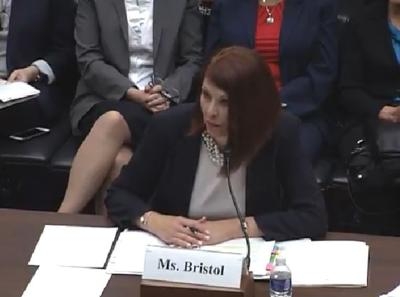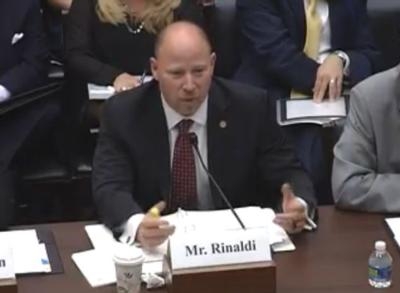Agency Has Missed Staffing Targets For The Past Six Years
The U.S. House Transportation Committee's Aviation Subcommittee held a hearing Wednesday focused on the FAA's staffing levels for Air Traffic Controllers.

According to research conducted by the committee staff, air traffic demand has declined significantly since 2000, which was the peak year for air traffic. According to the 2016 Controller Workforce Plan, since 2000, traffic volume has declined by 23 percent, with no expectation that traffic volume will return to peak levels in the near future. Despite this decline in traffic, the number of air traffic controllers has stayed constant. The number of controllers eligible to retire, which peaked in 2007 due to the retirements of those controllers hired after the 1981 controller strike, is expected to continue to decline over the next decade. In the last five years, 3,213 air traffic controllers have retired and 4,700 new controllers have been hired.
The FAA has missed its annual hiring targets in each of the last six years, which compounded staffing difficulties. In 2015, FAA missed the hiring target by 187 controllers. Despite these lower than expected hires, the FAA maintains that it is on track to reach its fiscal year 2016 hiring targets.
Over the last few years, FAA has made significant changes to its air traffic controller hiring process. The two most significant changes were the elimination of the hiring preference for graduates of FAA’s ATC Collegiate Training Initiative (CTI) schools and the introduction of a new Biographical Assessment (BA), a stand-alone, scored, multiple-choice exam that measures general and ATC-specific work experience, education and training, work habits, academic and other achievements. The BA replaced an “experience questionnaire” that was part of the Air Traffic Selection and Training Test (AT-SAT), which is a pre-employment aptitude test that measures a candidate’s ability to perform the role of air traffic controller.

Under the revised hiring process, candidates from CTI schools are grouped within a “Track I” applicant pool that consists of candidates from the general public. Track I candidates must pass the BA as a prerequisite for taking the AT-SAT. Applicants with at least 52 weeks of experience as a controller (i.e., former FAA or military controllers) are grouped separately within a “Track II” applicant pool. Unlike Track I candidates, Track II candidates are not required to take the BA, AT-SAT, or attend the FAA Academy.
The FAA maintains that the changes to the hiring process resulted in greater efficiencies and improved the process by ending the use of large inventories separated by applicant source, as well as opening a vacancy announcement available on the same terms to all U.S. citizens to ensure “equitable treatment." Under its February 2015 Track I vacancy announcement, 18,302 candidates applied and 2,801 were selected. Of the 2,300 candidates who applied under the FAA’s March 2015 Track II vacancy announcement, 989 were selected.

"It’s clear from numerous reports that the FAA has not hired and trained enough fully certified controllers, or CPCs, at our busiest ATC facilities to make up for the thousands of controllers hired during the 1981 strike, who are reaching mandatory retirement," said full committee chair Bill Shuster (R-PA) (pictured) in his prepared remarks.
"It’s not clear why the FAA has dropped the ball on controller hiring, placement, and training given the fact that these mass retirements were anticipated for years.
"Many of the problems can be attributed to poor management of the sequestration, as well as the timing and poor execution of significant – and questionable – changes to the controller hiring process.
"This is another example of the FAA’s long-standing inability to adequately manage its controller workforce. Under the status quo, passengers will suffer if the FAA is forced to reduce air traffic flows across the country due to a lack of controllers at key locations, including Atlanta, Chicago, Dallas-Fort Worth, Houston and New York. Today, we see news reports of the security lines in airports, but if the FAA can’t address this issue, we could see similar lines on the tarmac as well," Shuster said.
"In 2012 and 2016, the DOT IG found that a high percentage of the controllers at our busiest ATC facilities, including the terminal radar approach control facilities in Atlanta, Chicago, Dallas-Fort Worth, Houston, and New York, are so-called “developmental” controllers, or trainees, who cannot manage traffic without the direct supervision of a fully certified controller or facility manager," said subcommittee chair Frank LoBiondo (R-NJ). "In addition, of the 14,000-plus controller workforce, just over 10,600 controllers are fully certified, which is a 27-year-low.

"I am also concerned about the safety implications of the rising workload for CPCs, many of whom are subject to mandatory six-day work weeks and high rates of overtime.
"This drop in CPCs can be attributed to several factors. Over the past several years, the FAA has struggled to replace the thousands of controllers who were hired during the 1981 Professional Air Traffic Controllers Organization strike, most of whom have reached the agency’s mandatory retirement age of 56.
"The FAA’s hiring efforts were severely hampered in 2013, when the agency stopped training new hires at its training academy in Oklahoma City due to sequestration," LoBiondo (pictured) continued. "In 2014, the FAA abruptly changed its controller hiring process, and made even further poorly executed changes in 2015. Consequently, the FAA has missed its controller hiring targets for six consecutive years.
"To its credit, in the past year, the FAA has made some progress on the hiring front with the agency stating it will reach its hiring goal this year. Some of the internal bottlenecks that were highlighted at the December roundtable, including prolonged security and medical reviews, have been addressed. The FAA has also worked with NATCA on a revised policy to facilitate the transfer of fully certified controllers to the busiest ATC facilities.
"That being said, we have a long way to go."
In her prepared testimony, Teri L. Bristol, the FAA's Chief Operation Officer, Air Traffic Organization, defended the changes in hiring practices. "We believe these changes will improve efficiencies and have addressed the concerns identified in our initial reviews of the hiring process," Bristol said. "This process better addresses the agency’s current hiring needs. It also ensures equitable treatment and the broadest pool of qualified candidates.

"The biographical assessment is a computerized test that measures important and demonstrably job-related personal characteristics of applicants. Replacing AT-SAT with a validated alternative air traffic skills assessment eliminates the possibility that AT-SAT has been overexposed and is potentially compromised. We will continue to monitor and refine the process as necessary to ensure that the best possible individuals are selected to maintain the safety and efficiency of the NAS," Bristol (pictured) said.
NATCA president Paul Rinaldi said that the lack of long-term funding for the FAA over the past several years has been a factor in what he called a staffing "crisis."
"The FAA remains unable to adequately staff many of its large, high-volume facilities," Rinaldi (pictured, below) said. He also criticized the change in the hiring procedure. "Because the FAA did not work collaboratively to include NATCA in the process, that change led to the exclusion of a wholly different group of qualified applicants. Hundreds, if not thousands of qualified candidates were rejected as an unintended consequence of this new process."

He said an updated Biographical Questionnaire, developed with the help of NATCA, was an improvement, but "in the interim period, many candidates who had already passed the FAA's prior screen, the ATSAT test, were not offered positions."
(Source: House Transportation Committee. Images from file)
 ANN's Daily Aero-Linx (04.15.24)
ANN's Daily Aero-Linx (04.15.24) Classic Aero-TV: 'No Other Options' -- The Israeli Air Force's Danny Shapira
Classic Aero-TV: 'No Other Options' -- The Israeli Air Force's Danny Shapira Aero-News: Quote of the Day (04.15.24)
Aero-News: Quote of the Day (04.15.24) Airborne 04.16.24: RV Update, Affordable Flying Expo, Diamond Lil
Airborne 04.16.24: RV Update, Affordable Flying Expo, Diamond Lil ANN's Daily Aero-Term (04.16.24): Chart Supplement US
ANN's Daily Aero-Term (04.16.24): Chart Supplement US








